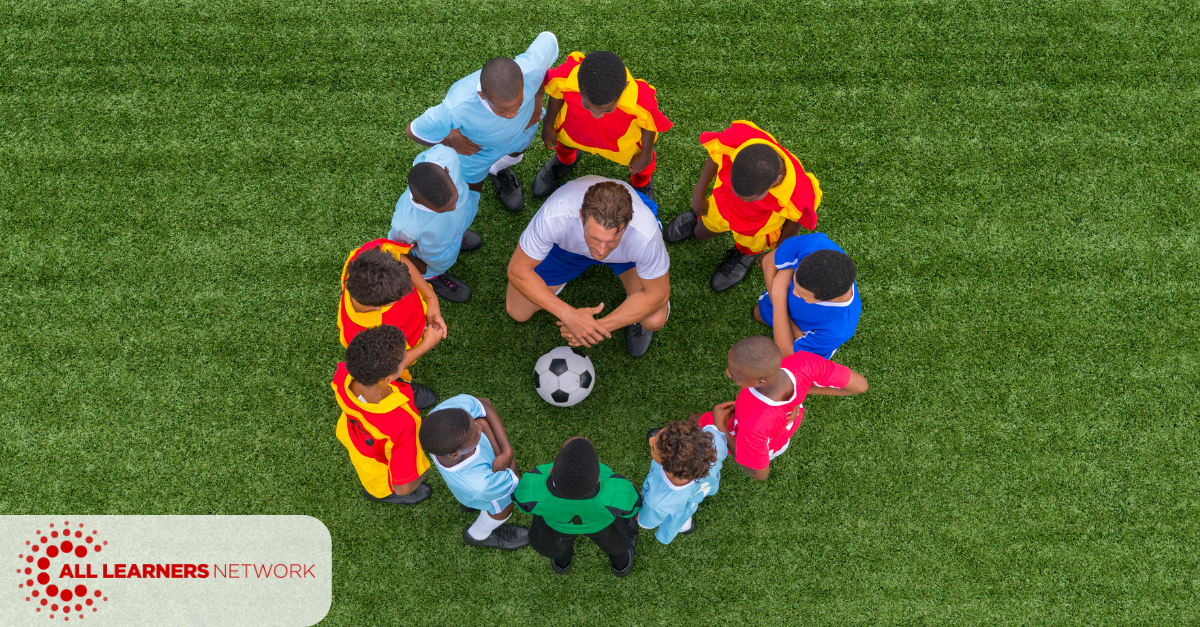
Erin’s Soccer Series, Part 3: The Soccer Club and Systemic Support
Published: May 9, 2025
The best soccer organizations or clubs are designed in a way that builds and develops the players throughout the organization. First, a soccer club defines the way in which their players will operate in some big ideas of soccer: defense, offense, goal-scoring, and tackling. These ways of playing are developed throughout the organization at every level. There is a common goal for how their players will operate as a team at the highest level. The coaches at every level in the organization know the full progression of skills that players will need to develop on the field.
Instead of this collaborative approach to player and team development, imagine if those coaches in the club operated in isolation. For example, one coach teaches zone defense, and then the next year, the players are with a coach who wants them to mark players in a man-to-man approach to defense. Imagine if the coaches at the lower level have no idea what is expected of their players when they reach the older teams. Imagine if the coaches at the highest levels don’t understand the foundational skills that players were taught when they were younger. They would be unable to help develop more advanced skills by building on the foundations that should have been established earlier. The result would be detrimental to the club and to the development of its players. Yet this is an accurate picture of what is happening in math instruction within many school systems. In our schools, the result is often learning opportunity gaps, misconceptions, and low math achievement for our students.
In well-run soccer clubs, the top coaches spend time with the lower level coaches and players. They model and show the best coaching practices to the newest staff members and youngest coaches while ensuring there is still high-quality practice for the most foundational skills they know their youngest future stars need to develop. This apprenticeship of observation ensures that even with their youngest players and newest coaches, the focus on development of the soccer club’s goals is maintained.
The best clubs develop an apprenticeship of observation among the players as well. The youth teams in the club are expected to watch the matches of their club’s most elite teams. In addition, the club’s most elite players are expected to spend time coaching and encouraging the youth program in the club during practices and camps. They are inspired to put in the hard work and practice required to constantly develop and improve as soccer players because they have a clear idea of what is needed to be successful at the higher levels.
Imagine, instead, if the higher level coaches never talked to or interacted with the coaches who were charged with their future stars. Their discontent with the way in which these players developed would be palpable. They may even feel anger and frustration towards those lower level coaches for not doing their jobs properly. This too often happens in our school systems. The middle school teachers lament over students’ lack of understanding of fractions, decimals, and division. Yet, ironically, we don’t see the system’s role in the incoming students’ lack of understanding when there is no structure for collaboration with the teachers, whose main responsibility is to begin the foundation for those concepts.
Opportunity gaps exist in the sport of soccer, just like they do in education. Clubs or organizations that don’t invest in their youth programs may have trouble finding older players who have the skill and development that is expected of them at the higher levels.
Not all practices are created equal. The way in which players are expected to work at practice greatly impacts the growth of their developing talent. The best clubs know this and establish high quality practice at all levels within their organizations. Concepts are interleaved from practice to practice. One day the coaches ask the players to think defensively and problem solve using their defensive structures and models. The next day the coaches ask the players to think offensively and problem solve using their offensive structures and models.
The best clubs are notorious for asking players to practice ideas, drills, and concepts they already know. They have the same drills and foundational skill expectations at every level of their practices. Professionals often practice a drill they’ve been a part of since their youth practices because it reinforces the foundational skills players need to be able to develop more and more advanced skills. Spacing practice of important concepts and foundational skills across practice at all levels in an organization helps their players perform better in game situations. The coaches know the more they can make these foundational skills a habit, the more the players can focus their cognitive energy on the complex team problem-solving involved in a 90 minute match.
The best soccer organizations combine this spaced and interleaved practice of the foundational concepts to the game of soccer with consistent feedback. Coaches on the practice field and sidelines at games view their role as distributing feedback that is “‘just in time, just for me information’” delivered when and where it can do the most good” (Hattie, 2017).
Excellent soccer coaches expect their players to independently problem solve and make decisions on their own during a game. So, a soccer coach’s goal is to constantly give players feedback about those choices so they can develop stronger and stronger choices during their independent problem solving in games.
I vividly remember my college coach standing next to me at practice when I was taking corner kicks for our team. First, he’d paint the vision of what I was striving for by reminding me that professionals can place the ball on any one of their teammates’ foreheads. Then he’d help me get better and more accurate with constant feedback after every kick. One day he said, “That one went way left, so now purposefully try to make this next one go way right”. Then find the middle on your third one.” He was giving me permission to mess up so that I could get stronger. His concrete feedback gave me something to focus on that helped me improve. He allowed me to make mistakes, sometimes even intentional mistakes, as part of the learning process in practice, so that in the game I’d be better prepared!
In conclusion, I believe that by examining the ways in which the best soccer coaches and organizations approach player development, we can reimagine a better way to approach systematic math instruction in our schools.
RESOURCES
Hattie, J., Fisher, D., & Frey, N. (2017). Visible learning for mathematics What works best to optimize student learning Grades K-12. Thousand Oaks, CA: Corwin.
Click here for the printable version.
What Now?
1. Read our blog “ALN Working with Systems” to learn how we can help create these systems within your school.
2. Check out our blog “Establishing Classroom Culture” for more on creating an environment where all students can succeed.
3. Bring All Learners Network (ALN) into your school or district for embedded professional development.

All Learners Network is committed to a new type of math instruction. We focus on supporting pedagogy so that all students can access quality math instruction. We do this through our online platform, free resources, events, and embedded professional development. Learn more about how we work with schools and districts here.





